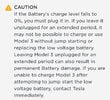I do not know if its getting better or worse, the conflicting info.Hi,
I can’t find a consensus. I see some people in the forum advocate
I took al battery care data from the latest Tesla Model 3 manual:
It can be a good idea to read these tips from Tesla. If there would be a big no-no, Tesla would say.



